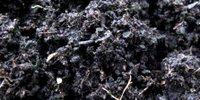Home › Garden soil › Soil basics
Soil Basics: What Every Gardener Should Know
So... down to soil basics! What are the essential things about garden soil that we need to be aware of as gardeners?
It boils down to these three important characteristics: soil texture, soil structure and pH value.
They are important because they provide vital information about your soil and its ability to support the type of plants you want to grow.
In a nutshell: the texture of your soil dictates the way that it behaves; the structure indicates its state of health from a gardening point of view; and the pH its degree of acidity or alkalinity.
A basic knowledge of these characteristics in relation to your own garden soil will help you garden more easily and successfully and eliminate a lot of trial and error.
Soil Basics: Texture
Soil is formed by the geological processes of weathering and erosion over thousands of years.
These processes break rocks down into mineral particles of sand, silt and clay. Sand particles are many times larger than particles of clay and silt falls somewhere in between.
It is the combination of these mineral components that determines the underlying texture of your soil and dictates the way that it behaves.
For example, sandy soil, with its larger particles, is free draining, whilst a clay soil, with densely packed tiny particles, is moisture retentive but prone to waterlogging.
The mineral components account for around half the volume of your soil with the rest made up of varying proportions of air, water, organic matter, plant roots and soil organisms.
Short of importing tons of topsoil there is relatively little you can do to alter the basic texture of your soil, and by far the easiest solution is to identify your soil type and then work with what you've got.
Tip: A really easy way to work out the texture of your soil is to carry out a simple soil identification 'feel test'. It will only take you a few minutes and requires no special equipment.
Soil Basics: Structure
Whilst the texture is determined by the combination of mineral components, the structure refers to the way they clump together to form larger crumbs of varying sizes interspersed with equally variable pore spaces.
This is important as the larger pores drain quickly and form pockets of air allowing room for root growth whilst the smaller pores retain the water and nutrients essential to growth.
Good garden soils have a wide range of crumb and pore sizes. Whilst it is difficult to change the underlying texture of your soil, you can improve the structure.
For example, the addition of well rotted organic material or humus, which is moisture retentive, helps the mineral particles bond together to form those all important crumbs.
So when people talk about improving garden soil, they usually mean improving the structure.

This photo shows a sample of soil from a border in my own garden that has had garden compost added over a number of years.
The soil itself is a silty sand but you can see how the addition of organic matter has improved the structure by encouraging the soil particles to form variable sized clumps.
Soil Basics: pH Value
Soils also vary in the amount of calcium, or lime, that they contain. This is really important because not only is calcium a vital nutrient in its own right, but it also affects the availability of other nutrients and plays a part in determining soil structure.
It also affects the types of plants that will grow well in your garden as some plants will only grow in lime-rich, or alkaline, soil, whilst others need lime-free, or acid, soil.
You can read more detailed information on this topic at soil pH and find out how easy it is to test your soil pH level using either a soil pH test kit or a soil pH meter. This is inexpensive and simple to do and will pay dividends in the long run.
Need More Information?
An overview of garden soil, and further links to soil related pages, can be found at healthy garden soil.
Home › Garden soil › Soil basics
